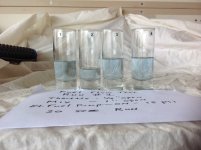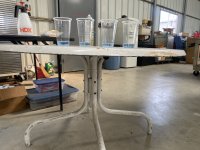ultimate10201
Member
I have what appears to be sticking exhaust valves on my freshly overhauled IO 360 A1B engine mounted in my RV7. This is an older engine that doesn’t have the counterweighted crankshaft.
Currently I have about 84 hours on the engine SMOH. The cylinders are reconditioned, steel nitride, .010 over, and were provided with new valves, seats, springs, pistons, pins, and rings. Break-in seemed normal and CHTs never got anywhere near out of hand – the highest I saw was #3 @ 375° which dropped down quickly within the first hour. My baffling and cooling works very well. I’ve never seen CHT‘s go over 360° in an aggressive climb on a hot day here in Texas and normal cruise will show a CHT spread from 320° to 345°.
I first noted the problem around 60 hours on my #3 cylinder. Currently, at start up, everything seems normal, EGT‘s climb as expected but after about 40 to 50 seconds, number three cylinder begins to drop out rapidly, #3 EGT drops from ~ 900° to < 300°, and the engine runs very rough. Very rough. I’m reluctant to let it keep running until it smooths out because it is so rough - literally shakes-the-airplane rough - but if I leave it alone, in about a minute, it smooths out and then I have a regularly operating engine with good throttle, mixture, and prop response for as long as I care to fly.
Surely does sound like a sticking valve that “heals” once it gets warm.
To add to the mystery, during the last 3 or 4 startups, #4 cylinder is beginning to misbehave similarly as well.
I’ve done all the ‘easier’ diagnostic things: tested the mags, the leads, the plugs, and I ran a fuel flow test which showed very even distribution. I removed the #3 rocker box cover, the rocker, the pushrods, the shroud, and I pulled out the hydraulic plunger assemblies just to be sure I didn’t have some kind of blockage or leak down anomaly.
I didn’t find anything obvious; and it still happens that everything works fine once the cylinder warms up; at that point, magically, the symptoms are just gone.
I’d appreciate any input before I go ahead and start trying the rope trick or possibly just pulling those two cylinders and taking them to the cylinder shop.
Currently I have about 84 hours on the engine SMOH. The cylinders are reconditioned, steel nitride, .010 over, and were provided with new valves, seats, springs, pistons, pins, and rings. Break-in seemed normal and CHTs never got anywhere near out of hand – the highest I saw was #3 @ 375° which dropped down quickly within the first hour. My baffling and cooling works very well. I’ve never seen CHT‘s go over 360° in an aggressive climb on a hot day here in Texas and normal cruise will show a CHT spread from 320° to 345°.
I first noted the problem around 60 hours on my #3 cylinder. Currently, at start up, everything seems normal, EGT‘s climb as expected but after about 40 to 50 seconds, number three cylinder begins to drop out rapidly, #3 EGT drops from ~ 900° to < 300°, and the engine runs very rough. Very rough. I’m reluctant to let it keep running until it smooths out because it is so rough - literally shakes-the-airplane rough - but if I leave it alone, in about a minute, it smooths out and then I have a regularly operating engine with good throttle, mixture, and prop response for as long as I care to fly.
Surely does sound like a sticking valve that “heals” once it gets warm.
To add to the mystery, during the last 3 or 4 startups, #4 cylinder is beginning to misbehave similarly as well.
I’ve done all the ‘easier’ diagnostic things: tested the mags, the leads, the plugs, and I ran a fuel flow test which showed very even distribution. I removed the #3 rocker box cover, the rocker, the pushrods, the shroud, and I pulled out the hydraulic plunger assemblies just to be sure I didn’t have some kind of blockage or leak down anomaly.
I didn’t find anything obvious; and it still happens that everything works fine once the cylinder warms up; at that point, magically, the symptoms are just gone.
I’d appreciate any input before I go ahead and start trying the rope trick or possibly just pulling those two cylinders and taking them to the cylinder shop.








